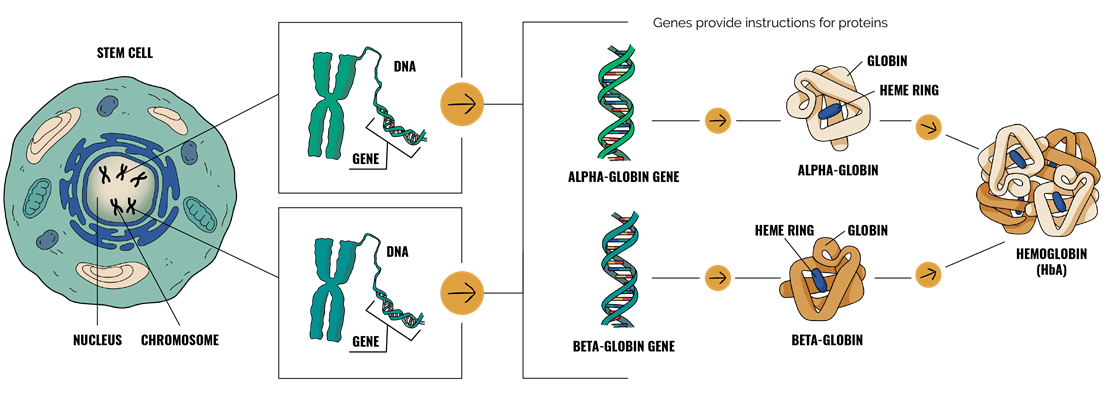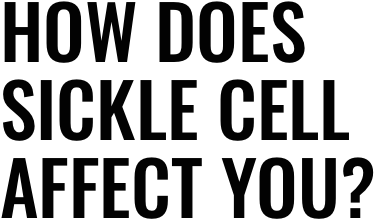Genetics of Sickle Cell
Sickle cell is a genetic, lifelong disease caused by an alteration in a gene that affects a person’s red blood cells.
Cells
the basic building blocks of all living things
DNA
the substance (or molecule) that carries genetic information in a human cell
Normal adult hemoglobin (HbA)
healthy form of adult hemoglobin produced when there is no mutation in the HBB gene and it does not stick together to cause sickling
“I did not understand sickle cell [when I was younger]. I had less education about it...So being educated on what sickle cell is made it a lot easier for me to understand myself.”
— Aaron, Sickle Cell Survivor
Genetics 101:
Cells, DNA, Genes, Proteins, and Your Sickle Cell
Every living thing is made up of one or many building blocks called cellsCellsthe basic building blocks of all living things. The human body has trillions of cells, and they are divided into many different types including muscle cells, bone cells, red blood cells, and white blood cells.
All cells work together to keep us alive. They carry out functions like converting food to energy. Some of them provide structural support, giving our organs and our body shape and strength.
Inside each cell is DNADNAthe substance (or molecule) that carries genetic information in a human cell, which provides instruction for the growth and function of living things. It helps determine our physical characteristics, and it’s also the carrier of genetic information.
All of your DNA is called a genome. Within the genome are many smaller sections of DNA called genes. Genes are like an instruction manual for your cells, and some genes provide instructions to make proteins.
Proteins are the workers of the cell. They perform a number of different functions within our bodies to keep us healthy, such as powering muscles, attacking invading bacteria, or delivering oxygen throughout the body.
Your body relies on cells, DNA, genes, and proteins to work together to function properly.
Genes and Proteins
To better understand how genes and proteins work together, it’s helpful to think of genes as the blueprint for your body. Just as a blueprint provides instructions to build things in a house like walls and windows, your genes provide instructions for your body to create proteins that carry out different functions within the body. Each cell in your body relies on thousands of proteins to do their jobs properly to function correctly.
However, a change (mutation) in a gene’s instruction can cause a cell or protein to not function properly. Although not all changes cause disease, some do.
Check out the video to learn more about how genes and proteins impact the symptoms and complications of sickle cell.
Mechanism of Sickle Cell Disease Mechanism of Sickle Cell Disease
Mechanism of Sickle Cell Disease Mechanism of Sickle Cell Disease
Red blood cells, hemoglobin, and the HBB gene
Blood is made up of four components including red blood cells, white blood cells, platelets, and plasma. It has several functions:
- Circulating oxygen and nutrients throughout the body
- Clotting blood to prevent blood loss
- Carrying cells and antibodies to fight infection
- Transporting and filtering waste through the kidneys and liver
- Controlling body temperature
Red blood cells are the most common type of cell in blood. Their job is to carry oxygen from the lungs throughout the body and move carbon dioxide from your organs to your lungs. This cycle allows oxygen to fuel your organs by giving them the energy they need to function.
There is a protein within red blood cells that picks up and carries oxygen throughout the body. This protein is called hemoglobinHemoglobina protein in red blood cells that helps carry oxygen throughout the body and is made up of four smaller protein subunits: two beta (β)‑globin proteins and two alpha (α)‑globin proteins. There must be a balance of both healthy beta‑globin and alpha‑globin in order for normal adult hemoglobin (HbA)Normal adult hemoglobin (HbA)healthy form of adult hemoglobin produced when there is no mutation in the HBB gene and it does not stick together to cause sickling to work properly.





We need to have more education. We need to have more easily accessible information. That’s what I wish I had more of, in a timely manner.
We need to have more education. We need to have more easily accessible information. That’s what I wish I had more of, in a timely manner.
JOYCE
Parent




